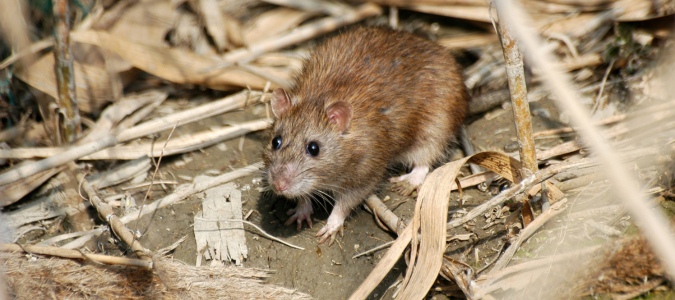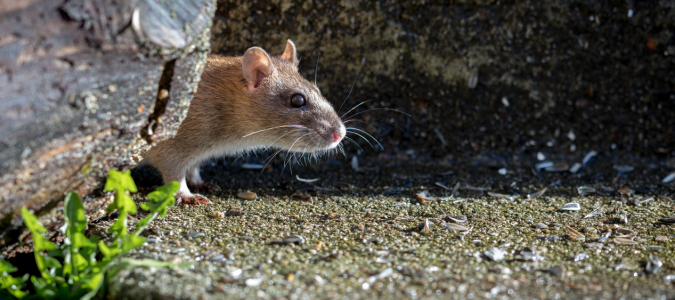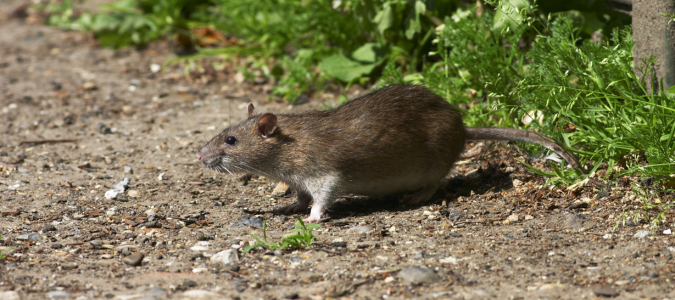Do you know how to spot a Norway rat and how to tell these pests apart from other rodent species? Norway rats are common, so it’s smart for homeowners to become aware of them.
Norway Rat Identification Guide
If you spot Norway rats in your home or on your property, do not hesitate to contact a pest control specialist. This species can spread diseases and wreak havoc on your home, so it’s important to deal with the problem as quickly as you can.
Norway Rat Appearance
Norway rats are considered medium to large-sized rats, and their bodies typically measure between seven and nine inches long. Unlike other types of rats or mice that are more slender, Norway rats are considered heavily-bodied.
They also have tails that are slightly shorter than the length of their bodies. From tip to tail, most Norway rats measure around 16 inches and weigh one pound. Norway rat tails are scaly and semi-naked, which is why they may be pink or tan in color. They start off thicker at the base of the tail and get thinner towards the tip.
The fur of Norway rats ranges from gray to brown, and they have either a white, off-white or gray underbelly. Their fur is known for being coarse and bristly, and sometimes it appears like they have black hairs speckled throughout their gray or brown coats.
Norway rats have delicate facial features. Their noses are blunt and their eyes and ears are small. Their ears are set close together and do not have fur on them.
Norway Rat Behavior and Eating Habits
Norway rats are typically most active at night. They are well known for their excellent burrowing skills. These pests create impressive underground tunnels to travel through and build their nests in.
Along with burrowing, Norway rats are also capable of climbing and swimming. They can easily get indoors through small gaps near doors and siding.
When it comes to their diet and eating habits, Norway rats are omnivores that will eat almost anything they can get their paws on. That includes fruits, vegetables, grains, meats, insects and more. They will happily eat any food that humans dispose of or leave out, which is why it’s common to find Norway rats scavenging through your garbage bins and compost pile.
Signs of Norway Rats
There are several ways to tell if you have a Norway rat problem, most of which are the signs that these pests leave behind. Since they are usually active at night, it’s likely that you won’t actually see a Norway rat unless you are awake at night and looking for them.
However, you can still discover a Norway rat problem during the day if you are paying attention. For example, a prime sign of Norway rats is their left-behind droppings. You may spot them in your home along the path from the Norway rat nest to their food source. Norway rat droppings are cylindrical with blunt ends, and they typically measure around three-quarters of an inch long.
Another clue that you’re dealing with Norway rats is the gnaw marks they leave behind on wood, wires or plastic materials. You may also notice Norway rat nesting materials in pockets around your home. They like to use shredded paper, cloth and vegetation to build their nests, and indoor populations are known for stealing items from your home.
If you hear scratching or scurrying sounds coming from inside your walls, floors or ceilings, it could be Norway rats moving around. It’s more likely to hear their movement at night when they are the most active.
Finally, you may notice Norway rat burrows on your property. Check near your foundation, under piles of debris and around your yard. Norway rat burrows have an opening that is several inches wide with a fan-shaped pattern of dirt around the entrance.
If you notice any signs of rats, contact a pest control service.
What Attracts Norway Rats to the Home?
Norway rats live both outside and inside; however, over time they have grown accustomed to living near humans. The main reason for this is that humans provide them with regular access to food.
Norway rats are drawn inside houses for food, water, shelter and warmth. They can find all of these necessities indoors while staying safe from outdoor predators. For example, open trash cans, spilled pet food and improperly stored dry goods are accessible food sources for Norway rats.
These pests can also find a regular supply of water from leaky pipes or standing water around your home.
How to Deter Norway Rats
Understanding why Norway rats come inside can help homeowners learn how to deter them. Since they are looking for a food source, one of the first things homeowners should do to make their homes less hospitable to Norway rats is to remove their dining options.
Keep all food in airtight containers, pick up uneaten pet food and keep a tight lid on trash cans. Repairing leaky pipes and other drainage issues will also remove their water source.
Next, homeowners should seal up any potential entry points into their homes to make it harder for Norway rats to get inside. Entry points include gaps, cracks and holes around the home’s exterior that are as small as half an inch.
Maintaining a clean yard is another way to deter Norway rats. These pests like to nest in debris and overgrown bushes, so keep the yard neat and tidy.
The best way to deter Norway rats is to consult with a professional pest control service. The experts will inspect the home and make personalized recommendations to control a Norway rat infestation.
Norway Rat Holes Identification and Tips
As avid burrowers, Norway rats can cause damage to your property. It’s important to be on the lookout for Norway rat holes and contact a professional as soon as you notice them on your property. The best way to minimize the damage Norway rats can cause is to catch a problem early.
Norway rats typically burrow near a home’s foundation, around trash cans or near overgrown shrubbery. They like to dig in concealed locations to stay safe from predators. Their burrows are between two and four inches in diameter, and they extend several feet underground. Norway rats can create an impressive network of tunnels, and they use an above-ground entry point to access them. They often damage plants and gardens by destroying the root systems.
Norway Rat Droppings Identification
How do you tell Norway rat droppings apart from other pest droppings? First, Norway rat droppings are shiny black or dark brown, and you often see them glistening in the light due to their glossiness.
Next, they have blunt ends that make them look like capsules or pellets. When the droppings are fresh they appear moist and soft; however, they harden and become brittle over time. They measure up to three-quarters of an inch long and one-fourth inch in diameter.
If you spot Norway rat droppings around your home, contact a pest control service. A professional can identify any rat poop, find where the Norway rats are nesting and control the infestation.
Contact Pest Control Pros to Deal With Norway Rats
Norway rats carry diseases and can cause property damage. It’s wise to deal with a Norway rat problem as soon as you recognize it. The best way to control these pests is by contacting a professional pest control company.
The experts can identify how the Norway rats are getting into your home and get to work controlling the infestation. They can also provide preventative services to deter Norway rats in the future.
ABC Can Help with Norway Rats
Managing a Norway rat problem can be unnerving for a number of reasons. If rodents, wildlife or any other variety of animal or insect pest is giving you trouble, contact ABC Home & Commercial Services. Our highly-trained pest specialists can help with rodent control on your property, so you can feel comfortable at home again.



